STEREO REVIEW'S SELECTION OF RECORDINGS OF SPECIAL MERIT
BEST OF THE MONTH
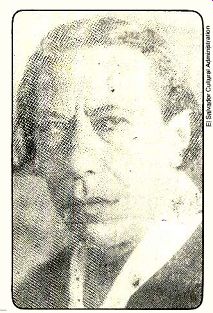
Barrios: A Brilliant Composer Rediscovered
UP until a few weeks ago, if anybody had asked me about Paraguayan music I would have rattled off a few top-of-the-head comments about the Trio los Paraguayos and what they owe to the Trio los Panchos, a short (very short) disquisition on Los Chiriguanos and what they owe to the Spanish colonial tradition, and concluded with a little rhapsody on that grandly compelling folk instrument known as the Guarani harp. All that has suddenly and irrevocably changed, however, with the re lease of a new Columbia recording by guitarist John Williams devoted to the music of Agustin Pio Barrios. From now on anyone who says "music" and " Paraguay" to me in the same breath is going to get "Barrios" right back.
Barrios was born in San Juan Bautista on May 20, 1885, and learned to play the guitar at an early age. He graduated from the Collegio Nacional with distinction in mathematics, philosophy, and literature, and beginning in 1910 he concertized extensively in Latin America. From 1934 to 1936 he toured in Europe, playing in Spain, Germany (on radio!), and Belgium, where critics com pared him to Segovia as an interpreter, to Cho in as a c .m-and t in San Salvador, where he died in 1944 of a heart ailment.
Astonishingly, his name is not to be found in any standard musical reference, including the fearfully comprehensive Music of Latin America by Ninini as a virtuoso.
Proud of his part-Indian ancestry, he adopted midway in his career the name Mitsuga Mangore, the Mitsuga part being an inversion of his first name, Agustin, the Mangore part the name of a legendary chief of the Timbue tribe at the time of the Spanish conquest.* He was something of an eccentric, appearing in concert at times dressed in native costume ("half nude, with feathers"-cf. Los Indios Tabajaras), but he was also an extraordinarily accomplished musician. He spent the last five years of his life as professor of guitar at the Conservatorio Nacional de Musica colas Slonimsky. (The liner notes pro vide a sketchy biography, and a more detailed one was kindly supplied by the Cultural Affairs department of the Or ganization of American States-in
-------------------------
*Mangore fell in love with Lucia Miranda, wife of one of the conquistadores, and was killed trying to abduct her. This was accomplished instead by his brother Siripo. Lucia's husband pursued, but was captured by the Timbue. His life was spared when he agreed to marry an Indian woman and leave Lucia to Siripo. Husband and wife were--later discovered together; she was burned alive, he (his name, naturally, was Sebastian) was shot with arrows.
There is more than a bit of the fanciful in all this, but it pro vides something of a clue to Barrios' own romantic tendencies, which are easily traceable in his music.
---------------
MUsica y MUsicos del Paraguay, by Dr. Juan Max Boettner. This neglect may be owing to the scholarly world's snobbish reluctance (up until recently, at least) to recognize the existence of the phonograph record. Barrios was apparently careless about manuscripts-in some cases there may not even have been any-but he did begin to record as early as 1909, reputedly the first classical guitarist to do so. A small under ground of enthusiasts has for some time been busy gathering together a body of works that may number in the hundreds, many of them painstakingly transcribed from the only source avail able-old phonograph records. Williams' album is the most recent record ed result of all this labor (there is an earlier album containing three Barrios pieces on Nonesuch 71349), and he has clearly been inspired. A superb musician and what I would call a "responsible" performer, he has usually fallen short, for me, of that carefree, chance-taking rapture the guitar ought to re lease in its finest exponents. No chilly reserve here, however: he plays with such virtuosic abandon that he might well have written the pieces himself.
But what about the music? You are probably going to have some little difficulty, as I did, understanding how mu sic of such quality can have been effectively hidden from the world for so long. Barrios knew the classics (a typical program, presented in Mexico, included Fernando Sor's variations on a theme from Mozart's Magic Flute as well as works of Beethoven, Chopin, and Albeniz) and knew what to do with such influences in his own works. La Catedral, the first piece on this new re cording, demonstrates that he knew his Bach too, but not in any sense of mere imitation. In everything he did-and he did everything from the classic forms to folk influences to popular song there is an immediately recognizable, individual voice, inventive in its melo dies, daring in its harmonies (some of them, indeed, verge on orchestration).
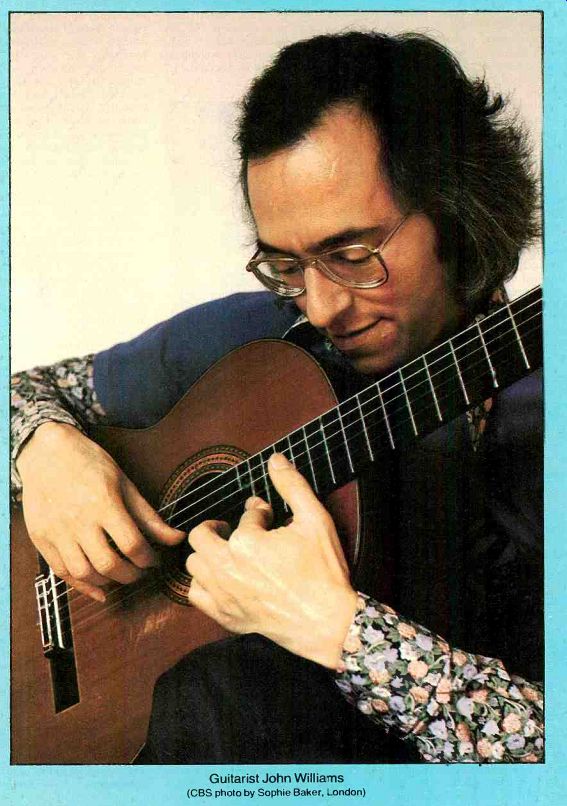
The whole is filled with a canny, often playful, and even theatrical dramatic
sense. In short, a COMPOSER.
I have not finished discovering new wonders in this sampling of Barrios' music, so I cannot yet point to any "fa vorites." This is a composer who re pays not only listening but study; I fer vently recommend that you do both. I also recommend that the Paraguayan government establish at once a Concurso Barrios to encourage other guitarists to play this music. With so many more works still to be recorded, Williams is going to need some help-Christopher Parkening, Angel Romero, and others take note. I look forward to the time when the Barrios entry will have ex panded to as much as a half-page in Schwann, and I would like to find listed there soon an LP transfer (perhaps dig itally cleaned up) of some of Barrios' own recordings. When you dream, dream big. -William Anderson
BARRIOS: John Williams Plays Music of Agustin Barrios Mangore. John Williams (guitar). La Catedral; Madrigal (Gavota); Minuet; Mazurka Appassionata; Estudio; Prelu dio; Sueno en la Floresta; Valse No. 3; Cueca; Aire de Zamba; Aconquija/Maxixa; Una Limosna el Amor de Dios; Choro de Sau dade; Villancico de Navidad. COLUMBIA M 35145 $7.98, MT 35145 $7.98.
--------------
Grainger Plays Grieg: Fabulous Old-fashioned Piano Playing in Modern Stereo Sound
IF you want to experience yesteryear's grand romantic style of piano playing coupled with excellent orchestral execution, the whole in up-to-date stereo sound (I can't think of any reason why you wouldn't), you will simply have to get hold of RCA's new 1978 recording of the Grieg piano concerto with Percy Grainger as the soloist and the Sydney (Australia) Symphony Orchestra under John Hopkins. Grainger in 1978? But he died in 1961 at seventy-nine! What's more, he never made a commercial re cording of the Grieg piano concerto, least of all with an orchestra from his native Australia, right? Yes-and no.
He never made one while he was alive, but he surely made one after he was dead, and this is it, stereophonic sound and all.
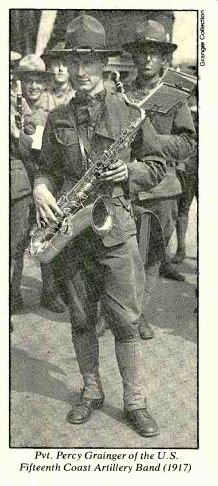
---------- Pvt. Percy Grainger of the U.S. Fifteenth Coast Artillery Band (1917)
Yes, it's the piano roll again. Grainger made the rolls for the Duo-Art company and they were issued in 1921, incorporating a Grainger-edited piano version of the orchestral accompaniment to make the whole comprehensible as a solo performance. Ah, the wonder of piano rolls! Fifty-seven years after the fact you can go back and edit out the now-unwanted "orchestral" material. Two gentlemen named Denis Condon and Peter Philips did just that and built a new Vorsetzer mechanism (with eighty "fingers" and two "feet") to play the resulting solo roll (role?). John Hopkins and the orchestra studied it, rehearsed with it, and produced the most estimable of orchestral accompaniments to go with it. Perhaps never has a piano soloist received an accompaniment more precisely tailored to his express musical wishes than Grainger has here. (Some times it pays to be dead.) Just in case you are unfamiliar with the specifically musical background of all this, Percy Grainger was a sensational pianist and virtually the "official" interpreter of his friend Edvard Grieg's piano concerto. Listening to this recording, it is not hard to see why. He is all over the keyboard. Bravura is there in abundance. So is ravishing lyricism, and, from pianissimo to fortissimo, the tone--the sound that comes not from the way a note is struck, but from the way all the notes are connected--is just extraordinarily beautiful. The performance is idiosyncratic, no doubt, the more so in that it was conceived as a solo rendition, not as one with orchestra, and there are phrasings that no one but Grainger would have dared use. But oh, what style, what musicianship, what communication! The Sydney Symphony Orchestra (I have never had the pleasure of hearing them before) is no mean ensemble either, and Hopkins does an absolutely remarkable job of integrating the orchestral parts with the rubato laden solo. Grainger desperately want ed to have his interpretation of the Grieg concerto realized on discs; per haps this will give his shade peace.
There are other, noncommercial recordings of him in the work, three of them (two complete and one of the first-movement cadenza alone) avail able on a disc issued by the International Piano Archives (IPA 508) which you can get in exchange for a $15 contribution to the Archives (P.O. Box 303, Ivor, Virginia 23866). The 1945 record ing with Stokowski shows Grainger rather ill at ease and Stokowski anxious to get through the thing as quickly as possible, but a 1956 performance with the (I'm not kidding) Southeast Iowa Symphony orchestra is perhaps even more astonishing pianistically (Grainger was seventy-four and played like he was twenty-five) than the present disc, though the piece is beyond the orchestra's abilities. The RCA amalgam offers the best of the matter, though; you simply can't hear this kind of playing in this contemporary sound elsewhere.
As if the Grieg were not enough, RCA has given us on the second side the recordings made of Grainger's own music by Stokowski (Grainger as solo ist in Handel in the Strand) and his orchestra, originally released in the early Fifties and long, long out of print. They are little treasures of light music, and I can think of no LP side I would rather have seen reissued. The recording, which is mono in this case, is perfectly acceptable.
-James Goodfriend
GRIEG: Piano Concerto in A Minor, Op. 16. Percy Grainger (piano roll); Sydney Sym phony Orchestra, John Hopkins cond. GRAINGER: Handel in the Strand; Irish Tune from County Derry; Country Gardens; Shepherd's Hey; Mock Morris; Molly on the Shore; Early One Morning. Percy Grainger (piano); symphony orchestra, Leopold Stokowski cond. RCA ARL I-3059 $7.98.
------------
Jimmie Mack: Life Can Be A Little Lonely On the Corner
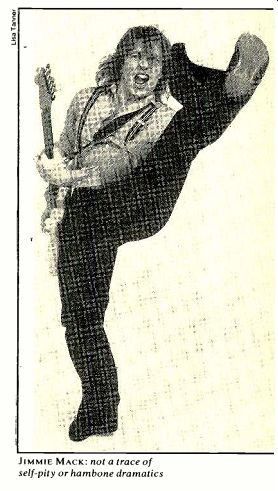
--------- JIMMIE MACK: not a trace of self-pity or hambone dramatics
JIMMIE MACK is a veteran of various bar ensembles and a semi-successful recording and touring group, the Earl Slick Band. With that kind of back ground one wouldn't expect more from him than the usual rock howling and foaming-but stand back. Mack is special, and his second solo album more than fulfills the promise of his first, "Jimmie Mack" (Big Tree 76007), re leased last year. It's been a long time since I've heard such good pop/rock writing (Mack's own) propelled by vocals that are husky, subtle, and absolutely convincing. I must also com mend the production by Elliot Scheiner, the string arrangements by Walter Raim, and the horn charts by Rob Mounsey. Together, these men have made a superb album.
Many of Mack's songs are about loneliness, but they differ from most songs of that genre and the way they are usually performed: there's not a trace of self-pity or hambone dramatics, either in the material or in the singing. With Mack, loneliness is a real condition, not just an excuse for a song. As with a broken arm, one deals with loneliness and lives with it until it heals; it is painful and even embarrassing, but it is not fatal.
I recommend the whole album be cause it is a complete, rounded artistic statement, but I must also cite a few outstanding performances: Ain't Gonna Make It, a cool recollection of a drunken night; I'd Rather Be the One, in which a man decides to put up with a woman's sometime love rather than have no love at all; and On the Ice, which takes on the question of identity and comes to the realization that it's going to take some time before the question gets answered.
Mack is successful as an artist be cause he doesn't strive self-consciously to be one. His vocals and the arrangements and production surrounding them are straight-ahead, no-non sense pop, easily worth more than the last fifty albums by fifty sniveling superstars caroling of defeat in the back seat of a Rolls. With common sense and courage, Mack takes responsibility for himself, and that is most refreshing in these days of whining bathos.
-Joel Vance
JIMMIE MACK: On the Corner. Jimmie Mack (vocals, guitar); vocal and instrumental accompaniment. Ain't Gonna Make It; On the Corner; I'd Rather Be the One; On the Ice; Give It Away; Lover; Pushin' Me; I Want the Night to Go On; Subway. BIG TREE BT 76014 $7.98, (;) TP 76014 $7.98, CS 76014 $7.98.
----------
Abravanel Leads Fine Performances of Two Appealing Works By Darius Milhaud
DARIUS MILHAUD'S Protge Suite, known to many of us only from the Monteux recording we have for years been after RCA to reissue, is one of the most substantial and appealing of the composer's early works for or chestra. It was produced in 1919, when he was twenty-seven-the same year as the more familiar (and slighter) Le Boeuf sur le Toit and some four years before La Creation du Monde. (The subtitle Suite Symphonique No. 2, by the way, does not identify the score as the second of two suites from Protge, but simply as the second work in Milhaud's cycle of symphonic suites, the only one he drew from his music for Claudel's play of that name.) More puzzling than RCA's reluctance to recirculate a recording that, after all, originated on 78's is the neglect the suite has suffered in general. I have never encountered it on a concert pro gram, and it is only now that its second recording makes its appearance. The handsome performance by Maurice Abravanel and the Utah Symphony Orchestra for Angel is even more welcome than the long-sought reissue might have been, and the coupling is a delightful surprise. Side two is some thing that might be regarded as a phonographic premiere, for the half-hour ballet suite Les Songes has been represented on discs heretofore only by the fragments recorded by Milhaud himself on two ten-inch Columbia 78's shortly after this work's Paris premiere in 1933, and by Gold and Fizdale's re cording (a ten-inch Columbia LP) of the brief three-movement adaptation for two pianos.
Les Songes, in which Abravanel con ducts the Utah Chamber Orchestra (the "core," one assumes, of the Utah Symphony), is of lighter texture, more intimately scored, and a bit less adventurous than the lustily extrovert Protge, but again highly attractive in its melodic abundance, rhythmic contrasts, and intriguing colors. For most listeners, both works are likely to be "discoveries," and 'both are very happy ones in deed, especially as presented on this beautifully recorded disc. (There is some pre-echo on side two, but per haps not enough to give concern.) There is probably no conductor alive who brings more authority and affection to the music of Milhaud than Mau rice Abravanel, and by now we can stop remarking on the fine job he has done with the orchestra entrusted to him thirty-three years ago and simply accept the fact of the Utah Symphony's high level of competence in the broad repertoire chosen for recording.
Neither of these points, it seems to me, has previously been made quite so impressively as both are here. Whether this package was Abravanel's idea or that of producer George Sponhaltz, it was an inspired one, and both are to be congratulated for bringing it off so brilliantly. James Ringo must be com mended, too, for his comprehensive notes on the background and content of the two unfamiliar works, just the sort of documentation so distinguished a re lease calls for.-Richard Freed MILHAUD: Protee, Suite Symphonique No. 2. Utah Symphony Orchestra, Maurice Abravanel cond. Les Songes. Utah Chamber Orchestra, Abravanel cond. ANGEL S-37317 $7.98, 4XS-37317 $7.98.
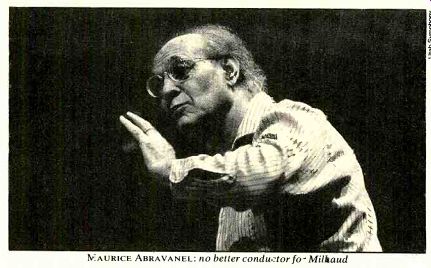
---------------
Herbie Mann: Disco So Good You Can Sit Down to It
SALES meetings at the major record companies must be rather fun these days, with vice presidents and producers trying to read sales reports and decide the fate of America's music by the reflected light of those slowly turning mirrored globes while secretaries hustle about in disco pants and Lucite shoes, the hush broken only by the creak of leather as the "gofer" returns with a pastrami on rye and an ounce of Colombian. More fun, surely, than it is around the turntable, where the aver age record buyer waits, breath bated, for the latest bad news from the nation's studios.
Purists and/or Puritans weep with moral outrage as one recording star after another is "forced to go disco" simply to get space on his company's re lease schedule, but it's not all downhill.
Listen, for instance, to Herbie Mann's new "Super Mann," just out on Atlantic, and see how well art and commerce can get along-if the artist concerned stands tall enough. It's a disco album, that's for sure, but it's also most definitely a Herbie Mann album, which means musical excellence of the first order.
This isn't Mann's first venture into disco, though; his single Hi-Jack topped the charts a couple of years ago, and his work since has retained a strong disco flavor. Wisely, producer Patrick Adams (the producer today is the key figure in any disco album, just as he was in the Hollywood film system of the Thirties and Forties) has tailored the music so that the disco sound is made to fit the Mann talents rather than the other way around. Since Adams wrote and arranged several of the tracks here (the best probably being the cool and elegant Django), he's kept firmly in mind that Herbie Mann is a jazz-flute virtuoso and doesn't seem to care in the least when the beat becomes subsidiary, as it often does, to Mann's sensational playing. The playful, relaxed, and sophisticated tone of the whole album is probably best summed up by the Jisco Dazz number, another Adams creation, in which Mann, the other musicians, and the singers seem to be having a wonderful time just playing, without engaging in any kind of no-holds-barred contest to out-freak each other.
"Super Mann" is one of the few disco albums I've ever been able to sit all the way through without getting bored.
How good it is to dance to-well, that's a question I'll sadly have to leave to others since neither the postman nor the Avon lady was in the mood. Shed no tears for Herbie Mann, however; he's doing his usual, excellent, own thing even in the midst of discomania.
With even Vladimir Horowitz being seen hanging out at Studio 54 these days (a fact that must send cold shivers down the spine of Arthur Rubinstein), it seems impossible to predict where this madness will end. I, for one, don't much care-as long as it produces al bums of the quality of "Super Mann."
-Peter Reilly HERBIE MANN: Super Mann. Herbie Mann (flutes); Patrick Adams, Nate Adderly Jr., Thom Bridwell, Leroy Burgess, John Cooksey (keyboards); Clarence Burke, Stan Lucas, Ken Mazur (guitars); Norbert Sloley (Fender bass); Richard Taninbaum (drums); Eddie Colon, John Cooksey, Michael Lewis (percussion); vocal chorus. Superman; Eta gui; Jisco Dazz; Rock Freak; Stomp Your Feet; Body Oil; Django. ATLANTIC SD 19221 $7.98, C) TP 19221 $7.98, CS 19221 $7.98.
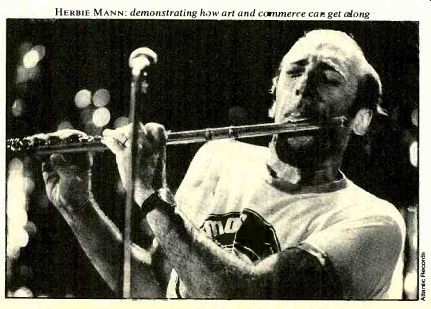
---- HERBIE MANN: demonstrating haw art and commerce call
get along
Also see:
AUDIO BASICS: From Infrasonic to Ultrasonic.
Source: Stereo Review (USA magazine)